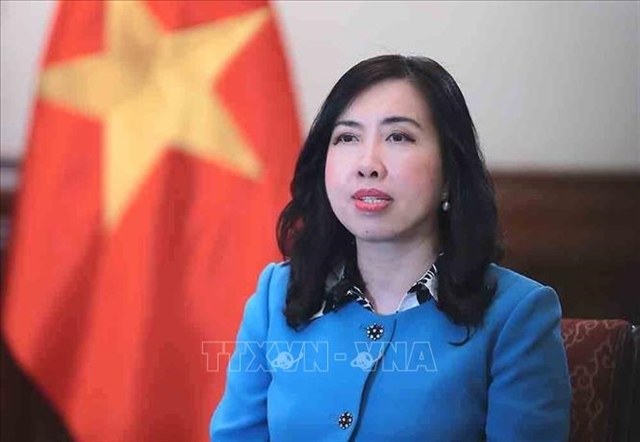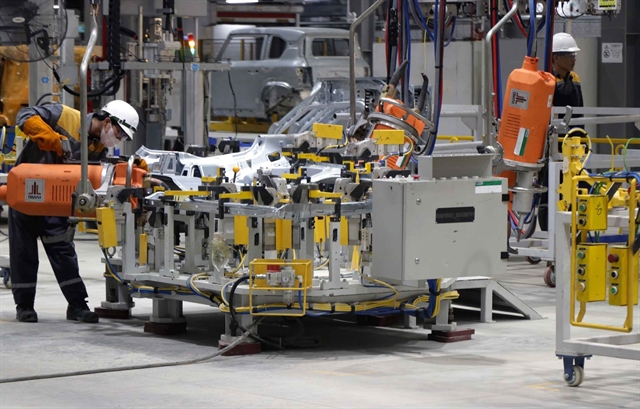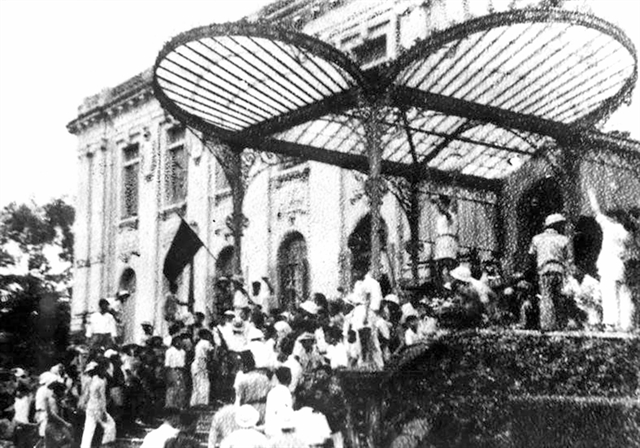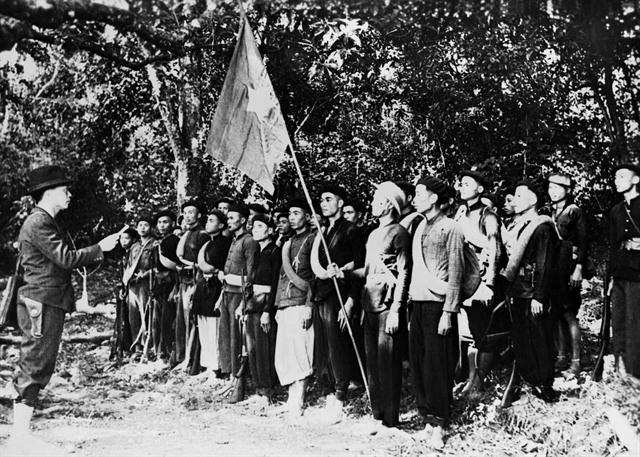 Politics & Law
Politics & Law


|
| On August 19, 1945, following a public meeting in front of the Opera House in central Hà Nội in support for the Việt Minh Front, demonstrators occupy the Tonkin Palace, the seat of the French-backed administration in the North of Việt Nam. VNA/VNS File Photo |
Over the past 79 years, the success of the August Revolution in 1945 in Việt Nam has stood as a profound testament to the wise leadership of the Indochinese Communist Party and its leader, Nguyễn Ái Quốc (later known as Hồ Chí Minh).
This monumental victory was forged through the unity, solidarity and unwavering determination of the Vietnamese people, who overcame immense challenges and made tremendous sacrifices. The revolution not only marked a new chapter in Vietnamese history but also set the nation firmly on a path of "national independence closely linked with socialism".
The August Revolution, also known as the General Uprising, was the first significant victory of the Vietnamese people under the Party's leadership, marking a pivotal moment in the nation's history. It showcased the Party's determination and strategic acumen, as it charted a revolutionary course with foresight, adaptability, and precise timing to ensure the success of the General Uprising in 1945. This triumph remains one of the most remarkable achievements of the Party, military, and people – an enduring epic in the struggle for national liberation.
The Party's leadership
After years of tireless efforts to find a way to save the nation, Nguyễn Ái Quốc embraced Marxism-Leninism, which became the foundation for his vision of national salvation. In 1924, Nguyễn left the Soviet Union for Guangzhou, China, where he established the Việt Nam Revolutionary Youth League, uniting patriotic and intellectual youths and providing extensive training to nurture them into communist revolutionaries.
On February 3, 1930, Nguyễn chaired a conference that unified communist organisations and established the sole Communist Party in Việt Nam. The birth of the Party was a significant milestone in the Vietnamese revolution, creating a nucleus that unified the nation's strength and aligned it with the trend of the times. This development was the most crucial prerequisite for the nation’s subsequent achievements, beginning with the successful nationwide General Uprising on August 19, 1945.
On March 9, 1945, the Japanese fascist army overthrew the French colonialists to take control of Indochina. In response, on March 12, the Party’s Central Committee issued the historic directive "Japan is at War with France, so Our Actions", identifying the Japanese fascists as the primary enemy of the revolution. Consequently, the Party launched a vigorous anti-Japanese movement, laying the groundwork for a general uprising to take power from the Japanese and the French.
The building of revolutionary forces began much earlier. With a sound political programme, the Party unified the strength of the entire nation, fostering a widespread revolutionary movement that engaged large sections of the populace in various forms of struggle.
Under the Party's leadership, the masses participated in the 1930-1931 revolutionary movement, the 1936-1939 democratic movement, and the 1939-1945 national liberation movement, tirelessly building and developing revolutionary forces in preparation for the General Uprising.
Nguyễn Ái Quốc returned to Việt Nam in January 1941, after more than 30 years away from homeland.
In May 1941, he convened the 8th Party Central Committee Conference to take a suitable way of struggle in the new period. It advocated the strengthening of national unity, gathering all classes, political parties, ethnic groups, and individuals with a revolutionary spirit to fight against French imperialists, Japanese fascists and their collaborators.
At this conference, the Party established the League for Việt Nam Independence, or Việt Minh Front for short, which unified all classes and groups, forming a solid national unity. The role and immense power of the Việt Minh Front were clearly demonstrated as it inspired the masses to join in the national liberation struggle.
To meet the revolution’s demands, on December 22, 1944, under the direction of Hồ Chí Minh, the Việt Nam Propaganda and Liberation Team (the precursor to the Việt Nam People's Army) was established to engage in revolution publicity and armed struggle, effectively combining political and military activities.
By mid-April 1945, Hồ Chí Minh and the Party’s Central Committee convened the North Vietnamese Military Conference, merging the Việt Nam Propaganda and Liberation Army and the National Salvation Army to form the Việt Nam People's Army. The revolutionary political and armed forces continued to grow and strengthen.

|
| The Vietnam Propaganda and Liberation Team, the predecessor of the Vietnam People's Army, was established on December 22, 1944 with 34 members under the command of Võ Nguyên Giáp, who later became general and commander-in-chief of the VPA. VNA/VNS Photo. VNA/VNS Photo |
Between 1940 and 1945, the Party actively directed the establishment and consolidation of revolutionary bases. The largest one was established in Việt Bắc, covering most of the areas of six mountainous provinces in northern North Việt Nam, along with several other armed struggle bases in regions across the country. These bases were strategic locations for building and developing revolutionary forces, serving as the nerve centres for leading the uprising.
Thus, during the pre-uprising period, the Party led the people in preparing every aspect for the General Uprising. The people of Việt Nam, particularly those in the "National Salvation" organisations, were determined to fight and ready to sacrifice for independence.
Seizing opportunity for uprising
Timing is crucial to the success of any revolution. Recognising the decisive and strategic importance of the revolutionary opportunity, the Party and Hồ Chí Minh acted swiftly and resolutely for the success of the August 1945 General Uprising/Revolution.
The opportunity for the August General Uprising emerged when the Imperial Japanese Army surrendered to the Allies. The Japanese army command in Indochina was in disarray, their soldiers seemed very demoralised, and their Vietnamese local collaborators gripped by fear. Meanwhile, the Party’s determination and the national salvation movement of the masses had reached its zenith. Local uprisings had already succeeded in many regions, and all forces were poised for action.
The uprising opportunity existed from when the Japanese fascist army surrendered until the Allied forces entered Việt Nam. It was a moment when the old arch-enemy had been defeated, while the Allied forces had not yet arrived, creating the most favourable vacuum of power for the revolutionary forces.
On August 16, the National Congress convened and passed a resolution to seize power nationwide and implement ten major policies of the Việt Minh. The National Liberation Committee, or the Việt Nam provisional revolutionary government, was formed with Hồ Chí Minh as president.
On August 18, President Hồ issued a call for a general uprising nationwide: “The decisive hour for our nation's destiny has come. All compatriots, rise up and use our strength to liberate ourselves… We cannot delay.”
In response to President Hồ’s call and under the Party’s leadership, the entire Vietnamese nation rose as one. Thanks to meticulous preparations and impeccable timing, the Uprising/August Revolution quickly achieved victory.
On September 2, at Ba Đình Square in the capital city of Hà Nội, President Hồ Chí Minh read the Declaration of Independence, establishing the Democratic Republic of Việt Nam, and ushering in a new era of independence and freedom for the nation.
A new era
The victory of the August Revolution marked the culmination of national unity, patriotism, and the indomitable will of the Vietnamese people under the Party’s leadership. It highlighted the resolve and intellect of the Party, led by President Hồ Chí Minh, who chose the correct revolutionary path with strategic foresight, agility, and the ability to seize the opportune moment.
The August Revolution opened a new era: one of national liberation intertwined with the liberation of the working-class and labouring people, and one of national independence closely linked with socialism. This was truly a leap forward in the historical development of the Vietnamese nation.
This victory proved that even a small nation, with a deep tradition of patriotism, self-reliance, unity, and creativity, under the leadership of a genuine revolutionary Party, can achieve events of great historical significance -- not only for the nation but also for the world at large. Nearly eight decades have passed, deepening our understanding of the immense historical significance of the August 1945 Revolution.
The revolution shattered the chains of French colonialism, Japanese fascism, and the local feudal regime, transforming Việt Nam from a colonial territory into an independent nation under a democratic republic. It elevated the Vietnamese people from slavery to becoming free citizens, masters of their own land.
The August Revolution not only is a shining milestone in the history of Việt Nam, but also an event of global significance, with profound international implications. For the first time, a small nation successfully fought to liberate itself from colonialism and imperialism. This victory inspired and encouraged colonised peoples and oppressed nations worldwide in their struggles for national independence, democracy, and social progress.
The victory of the August Revolution imparted many valuable lessons to Việt Nam, both in subsequent wars of resistance and in the ongoing effort to build and develop the country. Among these is the lesson of adjusting revolutionary policies when necessary, grounded in a sound revolutionary strategy and consistent goals. The Party has continually refined its policies to align with both domestic and international conditions.
A crucial lesson is the importance of seizing and capitalising on opportunities for victory. President Hồ Chí Minh’s mastery of timing during the August 1945 Revolution remains a valuable lesson for the present and future. This legacy continues to guide the entire Party and people in achieving significant and historically meaningful accomplishments in national development.
Another key lesson is the mobilisation of the entire population for the revolutionary cause and nation-building efforts. This includes fostering a spirit of self-reliance, fully harnessing the creative potential of the people, and expanding international cooperation.
Finally, the victory underscores the importance of building and consolidating national defence and people’s security, maintaining political and social stability, and preserving a peaceful environment conducive to national development.
Seventy-nine years have passed since the Vietnamese people took control of their own destiny. Despite many challenges, the revolutionary spirit and historical lessons of the August Revolution remain a powerful source of strength, guiding our Party and people as we continue to write new chapters in our nation’s glorious history. VNS